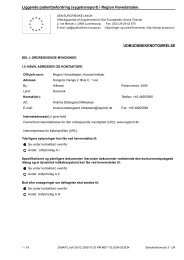Territorial Review Copenhagen - Region Hovedstaden
Territorial Review Copenhagen - Region Hovedstaden
Territorial Review Copenhagen - Region Hovedstaden
You also want an ePaper? Increase the reach of your titles
YUMPU automatically turns print PDFs into web optimized ePapers that Google loves.
180<br />
guidelines in the forthcoming Climate Change Action Plan (2009). The<br />
city‘s ambitious targets, especially with transportation and organic food, are<br />
laudable and reflect the administration‘s desire to decrease air pollution and<br />
increase liveability (Box 2.9). However, key commitments remain absent, in<br />
particular more conventional targets for water use, the residential sector and<br />
government buildings and services. While the <strong>Copenhagen</strong> Agenda 21<br />
(2004-07) explicitly targeted water conservation, groundwater consumption<br />
and water recycling were absent from the Eco-Metropole vision. 41 This is<br />
especially problematic given the Danish Meteorological Institute‘s forecast<br />
of temperature increases in Denmark by 3˚ to 5˚C by 2100. 42 Other cities<br />
have offered more refined plans for the residential sector and government<br />
buildings. Cape Town‘s Energy and Climate Change Strategy, for instance,<br />
established targets for energy efficiency in municipal buildings and more<br />
efficient lighting in households and city-owned housing (City of Cape<br />
Town, 2006; OECD, 2008). Equally important given the fluidity of much of<br />
the contamination in <strong>Copenhagen</strong>, additional effort needs to be made to<br />
forge such agendas on a regional basis. Promising initiatives exist on this<br />
front, e.g. the Capital <strong>Region</strong>‘s Soil Contamination Strategy (2007) and<br />
<strong>Copenhagen</strong> Capacity/Technical University of Denmark‘s forthcoming<br />
clean-tech cluster project, but additional work with regional air and noise<br />
pollution may be required.<br />
Box 2.9. Environmental targets for the city of <strong>Copenhagen</strong> (2015)<br />
Area Progress (2007)<br />
Air and noise pollution<br />
A reduction in <strong>Copenhagen</strong>‘s CO 2<br />
emissions by 20%<br />
<br />
<br />
<strong>Copenhagen</strong>ers should be able to<br />
sleep peacefully, free from<br />
harmful traffic-induced noise. All<br />
schools and institutions should be<br />
subject to only low traffic noise<br />
levels.<br />
The air should be clean enough<br />
not to damage <strong>Copenhagen</strong>ers‘<br />
health.<br />
<br />
<strong>Copenhagen</strong> emits a<br />
combined total of 2.4 million<br />
tons, or 4.9 tons per<br />
inhabitant (2005 figures).<br />
There are no current<br />
measurements for traffic<br />
noise levels at night. About<br />
40 000 dwellings are subject<br />
to excessive noise levels; 10<br />
schools and 20 institutions are<br />
subject to excessive noise<br />
from street traffic.<br />
<br />
In 2005, the limit for daily<br />
average value for PM10 (50<br />
μg/m3) was exceeded 64

















